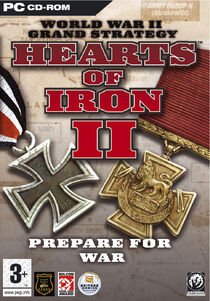
Hearts of Iron II is a grand strategy war game based on the years before, during and after World War II. The player can play as any nation that existed at the time; including major countries like France, Britain and Germany, and smaller nations like such as China, Australia etc.
The game usually begins in 1936, when the alliances have not yet fully formed and each nation must prepare themselves for the inevitable war in the years ahead. Germany is the only member of the Axis at this stage, while Britain heads the Allies and the Soviets the Comintern.
The player is able to control almost every aspect of their nation, from the type of government and its policies to the economy and the army. All aspects of the game need to carefully monitored and controlled by the player in order for their nation to be successful.
Diplomacy plays a very important role in Hearts of Iron II, as the player will need to negotiate with other nations for resource trading, building alliances or declaring war. The player's courses of action with diplomacy can alter the attitudes of other countries around them, for better or worse.
The main part of the game will concern the player controlling the armies of the selected nation, and using it effectively to accomplish key goals. Depending on the nation played, and its neighbours, the goals can range from total conquest of other nations to a partial gain of key territories.
Government
Hearts of Iron II allows the player to modify their nation's government with a series of sliders. The sliders affect the following:
- Whether your nation is a democracy or a dictatorship (or somewhere in between). Dictatorships tend to accumulate less dissent when declaring war, but have higher levels of partisan activity in occupied provinces.
- Whether your nation is left-wing or right wing (or in between), this affects the type of ministers in the goverment.
- How open or closed your nation's society is. It affects the amount of dissent within your nation, and also any controlled provinces.
- The economic policies of your nation. The slider ranges from a fully free market system to a centralised system. It affects the number of consumer goods created and the amount of money generated from your industry.
- Whether your army is a drafted or a professional one. Professional armies tend to have higher levels of organisation and will fare better in battle, but they are also slower to build up. Drafted armies are quicker to create but have lower organisation levels.
- Whether your nation favours war (hawk lobby) or peace (favours peace). Hawk lobby favours increased manpower production and faster production.
- How interventionist your nation is. Interventionist nations build less dissent during war declarations and are able to join alliances. Isolationist nations have troubles joining alliances unless circumstances (like war being declared on them) change.
Economy
Hearts of Iron II gives the player complete control of their nation's economy, ranging from resources to the available industry. Every nation has some amount of industry with which they can build and maintain a military and wage war. Larger nations like Germany, the United Kingdom, the USA and the Soviet Union have much more industry available for them to use. Minor nations have less industry, and are more of a challenge to play with.
Industry needs 4 major resources to function properly, these are energy, metal, rare materials and oil. A deficiency in any of these resources and industry will begin to shut down and limit a nation's ability to maintain its war effort. There are two other resources which are not critical for maintaining industry, but are needed for diplomacy and for maintaining the army; supplies and money.
- Energy is produced domestically, and is the most heavily used resource by industry. Each unit of industry uses 2 energy to maintain. Fortunately, most nations are self-sufficient in energy, and the ones which aren't are able to trade resources with other nations to acquire it.
- Metal is a fairly common resource, and is arguably the least used resource in the world. Each unit of industry requires 1 unit of metal for maintenance. Some nations don't have large amounts of metal (like Nationalist China), and need to trade with other nations for it.
- Rare materials are quite uncommon, and few nations have large surpluses of it (like the USA, the UK, the Netherlands and the Soviet Union). Trading of this resource is a must if a player decides to play with a minor nation. Each unit of industry requires 1/2 a unit of energy to maintain itself.
- Oil is arguably the most important resource for any nation. It is used both by industry and the army. The army uses oil as fuel for tanks, aircraft and ships. A severe deficiency of oil will result in a nation's industry and army shutting down, creating a dangerous situation during war. Each unit of industry requires 1 unit of oil to function. Some nations have plentiful supplies of oil, like the UK, USA, Soviet Union and Venezuela), and a wise player will stockpile large amounts of oil in anticipation of a lengthy war.
Besides the standard resources, manpower is the other major consumable resource. It cannot be acquired through conquest of other nations, and its rate of increase is dependant on the nation in question. Countries like the USA, Soviet Union and China have a large manpower capacity, being nearly inexhaustable. Smaller countries (like Australia, Netherlands etc) have much lower manpower growth, making it more difficult to build and maintain a large army. Manpower is used to build new divisions, or provide reinforcements for divisions which have sustained casualties during combat.